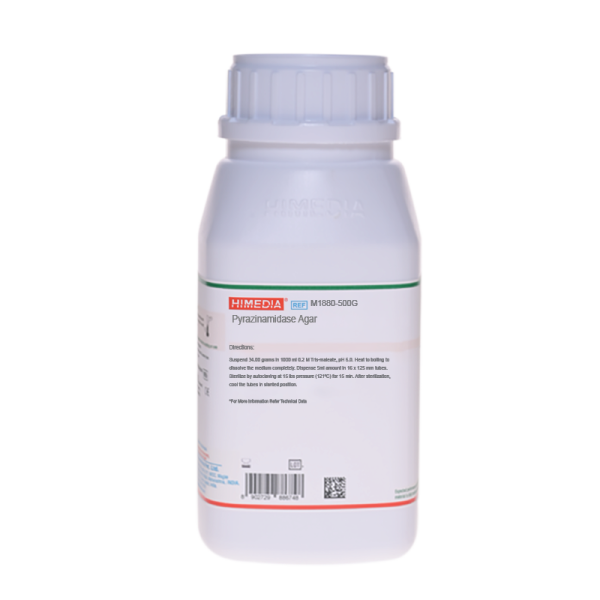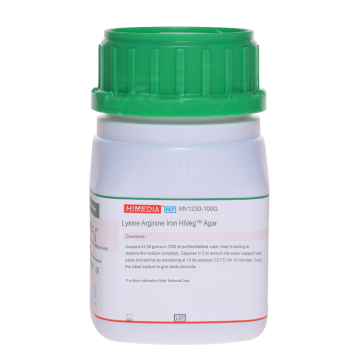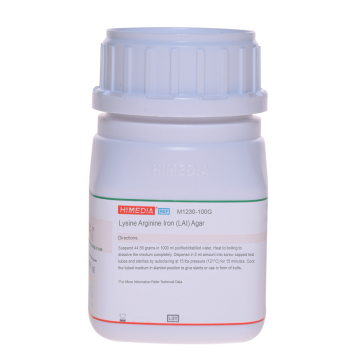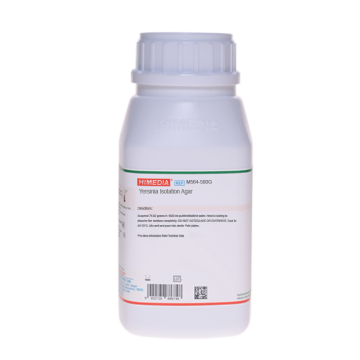 Your enquiry has been submitted
Your enquiry has been submitted
Pyrazinamidase Agar
Intended Use
Recommended for identification of Yersinia species in accordance with FDA BAM, 1998.
Composition
| Ingredients | Gms / Litre |
|---|---|
| Tryptone | 11.250 |
| Soya peptone | 3.750 |
| Sodium chloride | 3.750 |
| Yeast extract | 3.000 |
| Pyrazine-carboxamide | 1.000 |
| Agar | 11.250 |
**Formula adjusted, standardized to suit performance parameters
Directions
Suspend 34.00 grams in 1000 ml 0.2 M Tris-maleate, pH 6.0. Heat to boiling to dissolve the medium completely. Dispense 5ml amount in 16 x 125 mm tubes. Sterilize by autoclaving at 15 lbs pressure (121ºC) for 15 min. After sterilization, cool the tubes in slanted position.
Principle And Interpretation
Yersinia enterocolitica is a ubiquitous organism, isolated from soil, water, animals, and a variety of foods (7). They comprise a biochemically heterogeneous group that can grow even at refrigerated temperatures. The association of human illness with consumption of Y.enterocolitica - contaminated food, animal wastes, and unchlorinated water is well documented (1). Pyrazine Amidase Agar(M1880) is used for the identification of Yersinia sp. in accordance with FDA BAM, 1998 (4).
Pyrazinamidase activity distinguish potential pathogenic from nonpathogenic strains of Y. enterocolitica in epidemiological surveillance programs. Fully grown culture, on pyrazinamidase agar slants at RT is flooded with 1 ml of 1% freshly prepared ferrous ammonium sulphate over slant. Development of pink color within 15 min is positive test, indicating presence of pyrazinoic acid formed by pyrazinamidase enzyme.
Tryptone, soya peptone and yeast extract provides nitrogenous, carbonaceous compounds, long chain amino acids, vitamins and other essential nutrients. Sodium chloride maintains the osmotic balance of the medium. Pyrazine-carboxamide acts as substrate to detect Pyrazinamidase activity.
Type of specimen
Food and dairy samples - food, animal wastes; Water samples - unchlorinated water
Specimen Collection and Handling
For food and dairy samples, follow appropriate techniques for sample collection and processing as per guidelines (2,8,9).
For water samples, follow appropriate techniques for sample collection, processing as per guidelines and local standards(3).
After use, contaminated materials must be sterilized by autoclaving before discarding.
Warning and Precautions
Read the label before opening the container. Wear protective gloves/protective clothing/eye protection/ face protection. Follow good microbiological lab practices while handling specimens and culture. Standard precautions as per established guidelines should be followed while handling specimens. Safety guidelines may be referred in individual safety data sheets.
Limitations
- Some species may show poor growth due to nutritional variations.
- Further biochemical and serological tests must be carried out for complete identification.
Performance and Evaluation
Performance of the medium is expected when used as per the direction on the label within the expiry period when stored at recommended temperature.
Quality Control
Appearance Cream to yellow homogeneous free flowing powder
Gelling Firm, comparable with 1.13% Agar gel.
Colour and Clarity of prepared medium Light yellow coloured clear to slightly opalescent gel forms in tubes as slants.
Cultural Response Cultural characteristics observed after an incubation at 25-30°C for 48 hours. *-After incubation flood 1 ml of 1% freshly prepared ferrous ammonium sulphate solution over the slant.
| Organism | Growth | Inoculum (CFU) | Pyrazinamidase Test* |
|---|---|---|---|
| Yersinia enterocolitica ATCC 27729 | good-luxuriant | 50-100 | Variable Positive (development of pink colour within 15 mins) |
Storage and Shelf Life
Store between 10-30°C in a tightly closed container and the prepared medium at 15-25°C. Use before expiry date on the label. On opening, product should be properly stored dry, after tightly capping the bottle in order to prevent lump formation due to the hygroscopic nature of the product. Improper storage of the product may lead to lump formation. Store in dry ventilated area protected from extremes of temperature and sources of ignition. Seal the container tightly after use.
Product performance is best if used within stated expiry period.
Disposal
User must ensure safe disposal by autoclaving and/or incineration of used or unusable preparations of this product. Follow established laboratory procedures in disposing of infectious materials and material that comes into contact with clinical sample must be decontaminated and disposed of in accordance with current laboratory techniques (5,6).
Reference
- Aleksic, S., A., Steigerwalt, J., Bockemuhl, G., Huntley-Carter. and Brenner, D.J 1987. Int. J. Syst. Bacteriol, 37: 327-332.
- American Public Health Association, Standard Methods for the Examination of Dairy Products, 1978, 14th Ed., Washington D.C.
- Baird R.B., Eaton A.D., and Rice E.W., (Eds.), 2015, Standard Methods for the Examination of Water and Wastewater, 23rd ed., APHA, Washington, D.C.
- FDA, U.S. 1998. Bacteriological Analytical Manual. 8 ed. Gaithersburg, MD: AOAC International.
- Isenberg, H.D. Clinical Microbiology Procedures Handbook. 2nd Edition.
- Jorgensen, J.H., Pfaller, M.A., Carroll, K.C., Funke, G., Landry, M.L., Richter, S.S and Warnock., D.W. (2015) Manual of Clinical Microbiology, 11th Edition. Vol. 1.
- Sabina, Y., Rahman, A., Ray, R.C. and Montet, D. 2011. Journal of Pathogens, 2011.
- Salfinger Y., and Tortorello M.L. Fifth (Ed.), 2015, Compendium of Methods for the Microbiological Examination of Foods, 5th Ed., American Public Health Association, Washington, D.C.
- Wehr H. M. and Frank J. H., 2004, Standard Methods for the Microbiological Examination of Dairy Products, 17th Ed., APHA Inc., Washington, D.C.
| Product Name | Pyrazinamidase Agar |
|---|---|
| SKU | M1880 |
| Product Type | Regular |
| Physical Form | Powder |
| Origin | Animal |
| Packaging type | HDPE |
| References | 1.Sabina, Y., Rahman, A., Ray, R.C. and Montet, D. 20 |
| Customized Product Available | No |









